Category Archive for Spain
Hip Valencia, Spain! Santiago Calatrava City of Arts & Sciences, Michelin restaurants, futuristic architecture.
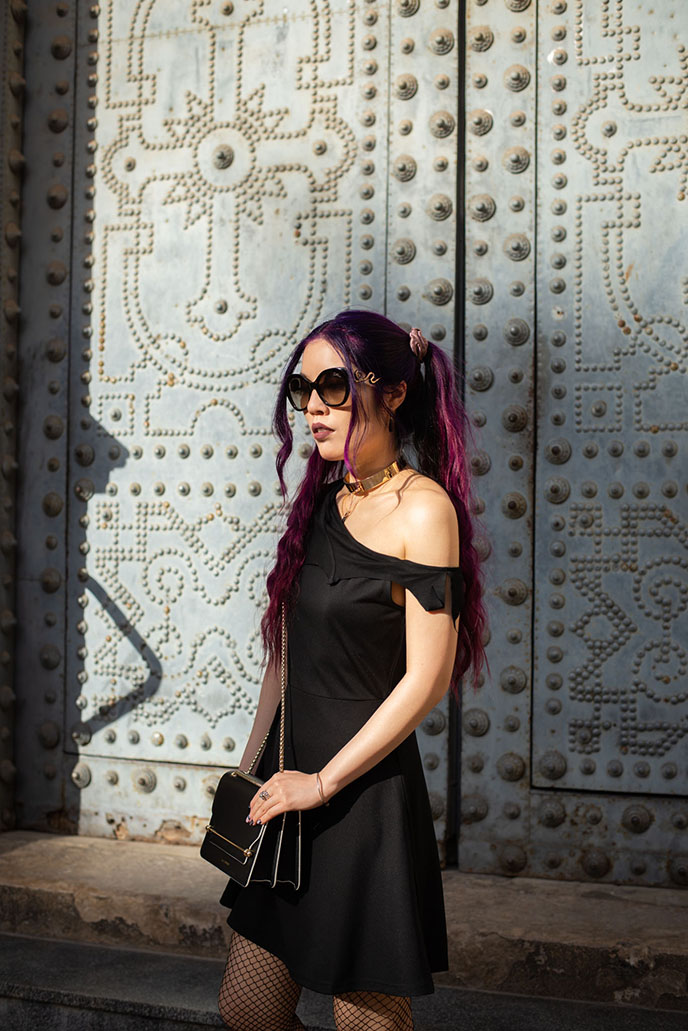
Valencia tends to be overlooked by travelers to Spain, who tend to visit well-known spots like Barcelona. But as you’ll see in this photo diary, Valencia is a gem of a destination with space-age architecture, Baroque carvings, Michelin-starred restaurants… and for you Goths out there, the city even has a bat as its mascot.
This mega-post will cover it all, along with outfit photos taken in the most Instagrammable locations in the city. (I was delighted to be invited to Valencia by the tourism board last November.)
Outfit details: Robert Cavalli snake sunglasses, Strathberry East / West purse, Fantasmagoria dress with batwing collar. See more with a click below:

Let’s start by visiting the City of Arts and Sciences, which looks like a scene from The Jetsons. Designed by Spanish architects Santiago Calatrava and Félix Candela, Ciutat de les Arts i les Ciències was inaugurated in 1998, with additional buildings added to the complex up to 2009.

My devilish look for the day included a Strathberry crossbody purse, and Satanic dress with a pentagram straps / harness detail.

You can easily spend hours exploring the enormous Valencian cultural / architectural complex. The many curving, white modern structures include L’Umbracle — a landscaped garden dome that includes a Walk of the Sculptures.

Here is Museu de les Ciències Príncipe Felipe — an interactive science museum of science with a roof designed to resemble the skeleton of a whale.
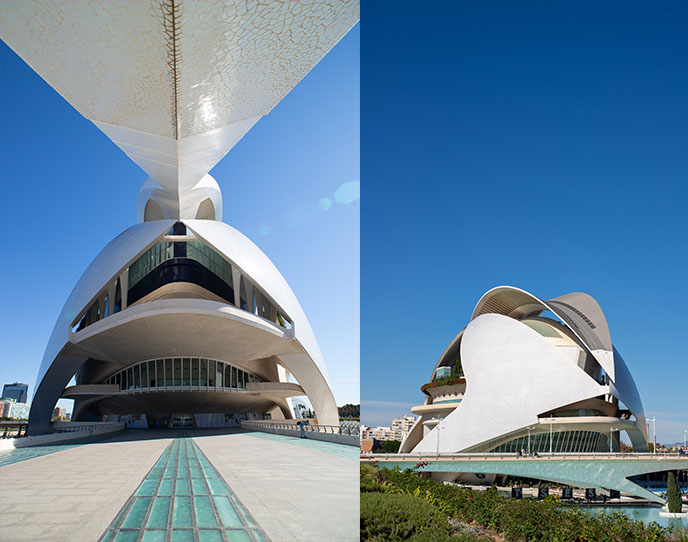
Behold, the Palua de les Arts Reina Sofía — an opera house and performing arts center surrounded by water. Many leading musicians have performed within these eaves.
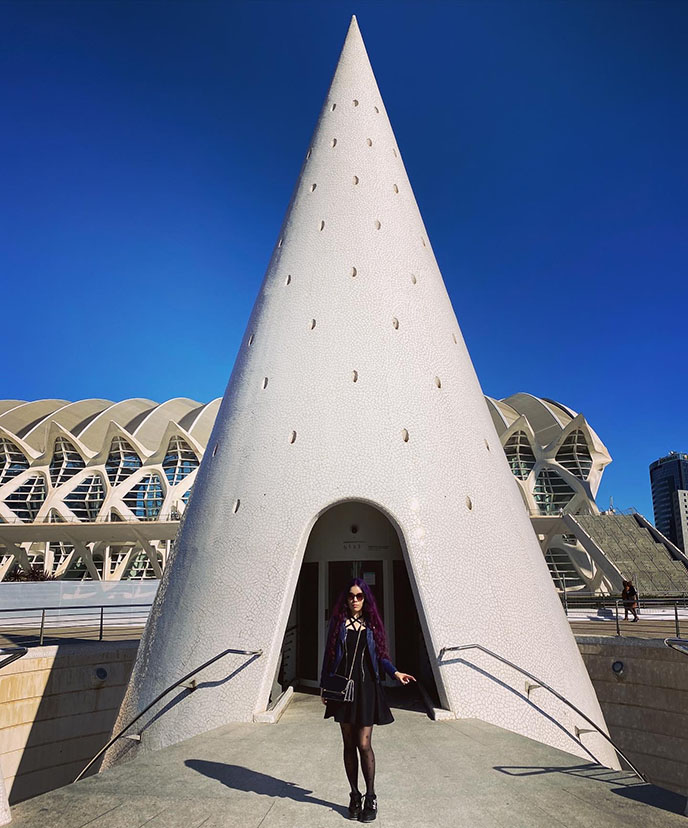
I let my imagination run wild, as I walked around the City of Arts and Sciences. The geometric, bone-white designs made me feel like I was in a sci-fi movie. These cone simply holds an elevator that leads to the garage!

The Ciutat de les Arts i les Ciències includes L’Hemisfèric, which contains an IMAX Cinema, planetarium and laserium. The building is meant to resemble a giant eye of knowledge.

I enjoyed walking around Calatrava and Candela’s buildings, and noting how the shapes changed when viewed from different angles.

There were so many fascinating elements that I couldn’t photograph them all. The City also includes L’Oceanogràfic, an open-air oceanographic park, and a curving white cabled bridge called Assut de l’Or.

You’ll be hard-pressed to find a better spot for Instagram and fashion photography. (Strathberry purse, and see more items below):

I’ve long been a fan of architect Santiago Calatrava, known for his white spaceship-like designs inspired by organic forms. You may recall I saw his Brazil Museum of Tomorrow and World Trade Center subway station in NYC.

Duck under Montolivet Bridge, and see the glimmering reflections of the water on the concrete curves.

Look for the light in unexpected places… This is a transportation area that turned out to be a great shooting spot.

There are rotating public art exhibitions throughout the City. This rather emo bunny rabbit sculpture is “Aqui Estamos” (Here We Are) by Leiko Ikemura.

Details, details. Can’t get enough of the architectural creativity, such as the zig-zag stair railing that mirrors the peaks of the roof and windows.

All photos by Joey Wong — love how he always finds that sliver of light.

Isn’t the City of Arts and Sciences dazzling? I half-expected a UFO to land here.
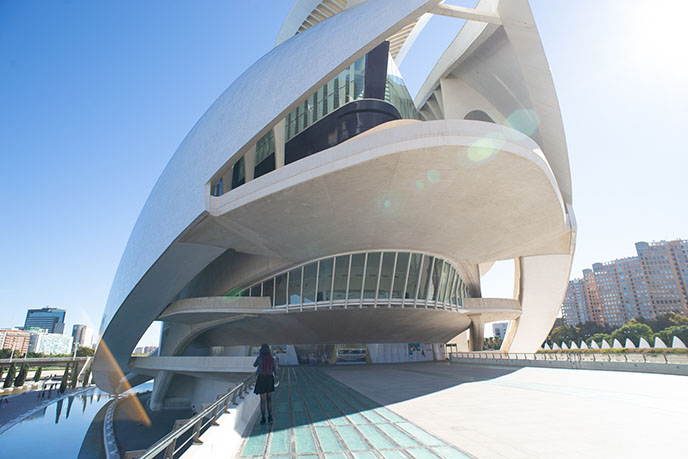
Don’t miss this eyepopping site if you’re in Valencia. Bring a camera, and enjoy the various events, performances, and museums within it.

Valencia Tourism also took me on a city tour to see the historic side of the city — which is just as fabulous. The main district is filled with churches, buildings, sculptures, fountains and pavilions that date back centuries.

The star of the show is Valencia Cathedral, also know as Saint Mary’s. Consecrated in 1238, the church is a fine example of Valencian Gothic architecture.

The ornate chancel of Valencia Cathedral is decorated with colorful 15th-century paintings.

Outside, be sure to snap a photo with the oldest door in the city, which is framed by multiple arches.

I learned that Valencia’s symbol is the bat — how vampiric! The nocturnal winged creature has perched atop Valencia’s coat of arms since around 1238, when King James of Aragon was fighting the Moors. Legend has it a bat landed on his flag and brought him good fortune, as he won the battle.

Look up as you walk around Valencia, and you’ll find the bat mascot everywhere — much like Batman’s beacon in Gotham City.
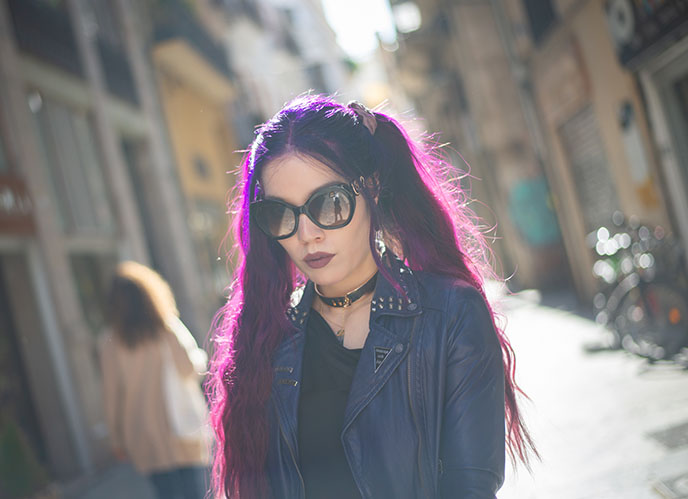
The bat element makes Valencia a fitting city for Goths! (Wearing Robert Cavalli oversize designer sunglasses.)

The walking tour continued on to Mercado Central, the major food market of Valencia. Completed in 1928 by Valencian architect Enrique Viedma Vidal, it is a stunning example of Spanish Art Nouveau.

The interior is a feast for the senses. You’ll find every type of vendor along with Iberian hams hanging from posts, and stacks of bright Valencian oranges (which are delicious).
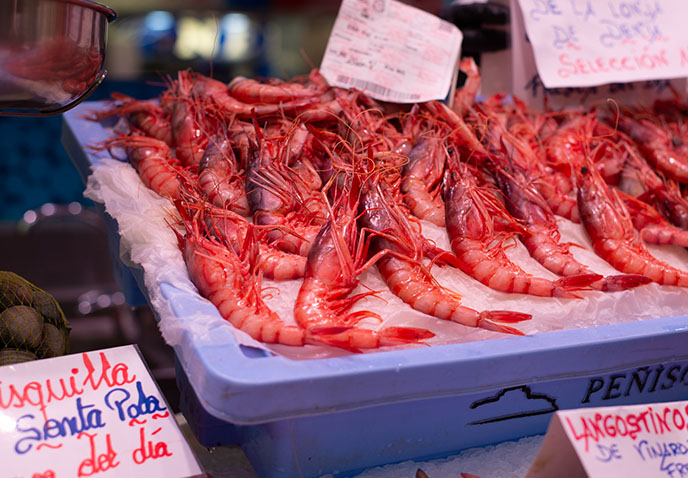
The seafood section is particularly tantalizing. Above are the famous Denia prawns found only in the waters near Valencia, and known as the tastiest and most expensive in the world.

On this trip, I met Valencian chef Danny Lledo and interviewed him about his quest to serve Denia prawns (gambas rojas de Denia) for the first time in America, at his DC restaurant Xiquet. Read my article about his journey here, in my debut for AFAR Magazine!
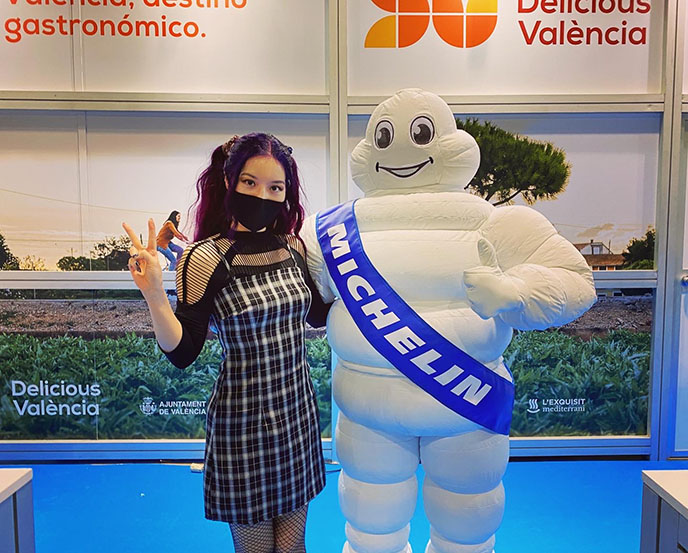
I also wrote an article for Fodor’s Travel about how Chef Danny Lledó turned his hometown cuisine into a Michelin star. Read how the chef’s childhood in a fishing town paved his path to winning paella championships and opening Michelin-starred D.C. restaurant, Xiquet.
I was a guest of Valencia’s Mediterranea Gastronoma food festival… and met the Michelin man himself!

Spain is known for its boundary-pushing culinary scene, and Valencia is home to a number of restaurants starred by the Michelin Guide.
I adored the industrial-style open kitchen and Argentinian-influenced tasting menu at Fierro. At the top: hake fish with seaweed, citrus, and pil pil (a collagen-rich sauce). Below: a creative dish entirely made from parsnips, including picked parsnips that have a spicy touch much like wasabi. The wine pairings were excellent such as Galician-grown whites), and Gran Fondillon dessert wine made from Monastrell.

I also ate at Michelin-starred La Salita, which had a whopping 16 courses prepared in innovative ways. The amuse bouche plate was beautifully presented: it includes corn tostada, colorless gazpacho, and a chilled caprese bite, decorated to look like flowers and a butterfly.
Each dish came with a story: the focaccia on the right was inspired by the bread brought by soldiers to war, which they softened with olive oil (La Salita uses Lagrima, the finest one). It was served with an eel soup with ikura (salmon roe), green apple, and cilantro — and paired with wines from the Valencian mountain region.

At a time when travel experiences are few and far in between, I feel unbelievably lucky to have done a food and culture journalism trip like this in Valencia.

After being in North America for two years, it felt like a palate-cleanser to be in a very different country / culture, and see buildings that dated as far back as the Middle Ages.

Artistic details like these make me happy. Would you dare to put your hand in the lion’s mouth?

Leave it to me to find bats throughout Valencia.

And I think this takes the cake for “most epic door.” This is the Palacio del Marques de Dos Aguas, which has now become the González Martí National Museum of Ceramics and Decorative arts.

The Valencian palace / museum’s main entrance is surrounded by Baroque alabaster sculptures.
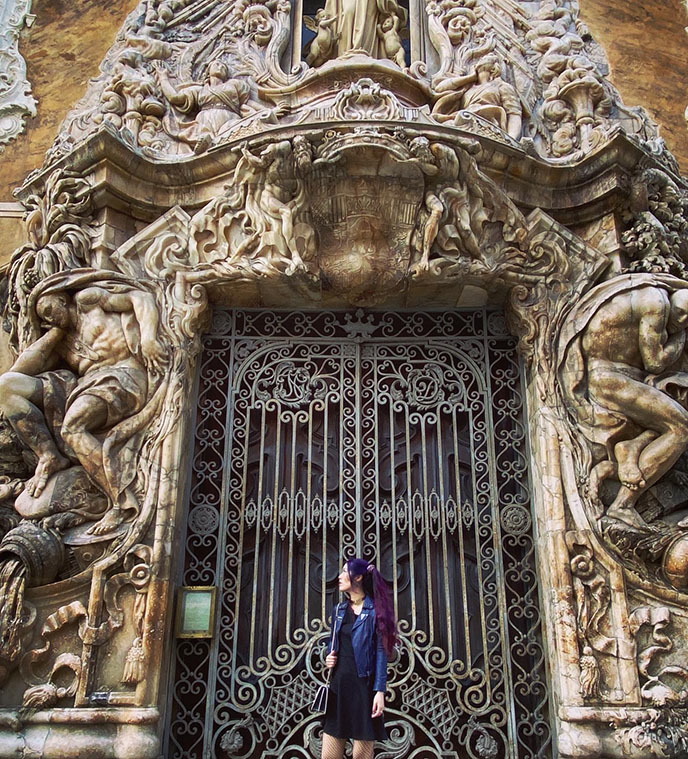
The amount of details in this doorway… phenomenal.

Museo Nacional de Cerámica y Artes Suntuarias González Martí is dedicated to ceramics (with a focus on Valencian ones), porcelains and other decorative arts such as textiles, costumes, and furniture.

I happened to wear a one-shoulder dress from Fantasmagoria with a batwing design at the collar… how fitting for a day exploring Valencia!

Details, details. My large gold choker necklace is the Safety Chain by Eddie Borgo. Sunglasses are Robert Cavalli.

Look up to see stately stained glass rotundas… and a gargoyle pleasuring itself!

Some travel outfit inspiration for you. I wore these Anthony Wang platform sneakers and a loose dress so that I could walk around comfortably all day. I dressed it up with fishnets and a leather jacket, and tied my hair with silk scrunchies.

A final Baroque facade: this is Church of the Santos Juanes (Església de Sant Joan del Mercat).

I hope this story convinces you to add Valencia to your itinerary, if you’re traveling in Spain!
If you liked my outfit of the day, you can find these designs below:

And cheers to all for reading and featuring The Little Book of Satanism! My latest book is featured in Auxiliary Magazine, as well as publications like Forbes and CBC.
You can get a copy of my “The Little Book of Satanism” from Amazon ♡ Kindle (digital) ♡ Barnes and Noble ♡ Bookshop and other retailers worldwide. Thank you for your kind support!
SHARE & COMMENT
Dorawyn apocalyptic fashion! Dune x Star Wars film style in Seville, Spain: Plaza de Espana, Real Alcazar, Casa de Pilatos.

We live in apocalyptic times… and I’m dressed to meet The Collapse head on!
Let me show you more of Seville, Spain’s historic sites –wearing Dorawyn, a conceptual, experimental slow fashion brand that reminds me of the outfits in the Dune movie (which I very much enjoyed).
Located in the south of Spain, Sevilla was the filming location for scenes in Star Wars: Ep 2, Game of Thrones, and Lawrence of Arabia as well.

The Arabic architectural elements formed the perfect backdrop to shoot Dorawyn’s “Bunker” Collection. I am wearing her “Keyword” wrap cardigan, which can be tied at the waist and has a hood to protect you from the sun and sandstorms. My Dorawyn “Uprise” black fingerless gloves complete the look.

This magnificent palace is the Real Alcázar, or Royal Alcázars of Seville, which is one of Sevilla’s most famous sites. The palace was first built for the Christian king Peter of Castile in the 14th century. Above the Patio de las Doncellas (Courtyard of the Maidens), which references a Moorish tale.

The palace was built over the site of a Muslim alcazar, or residential fortress. The Mudéjar architecture retains Arabic elements such as these tiles and rounded arches, and adds Romanesque, Gothic, and Renaissance influences.
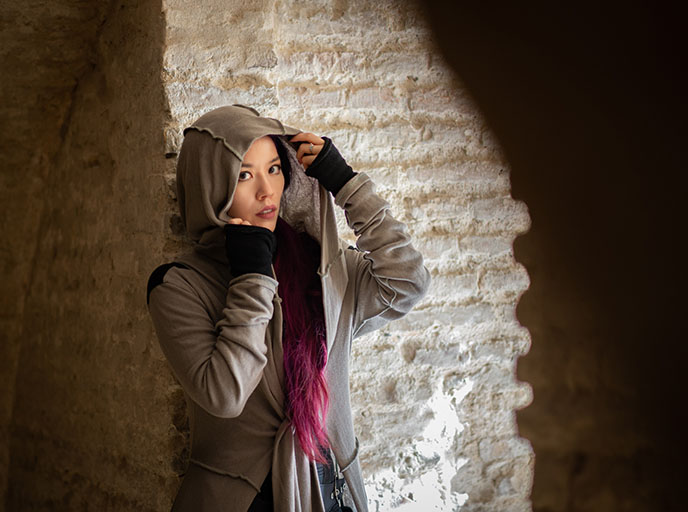
The Iberian Real Alcazar was the perfect site to feature fashion by Dorawyn, a Budapest-based label designed by Dóra Tesényi. Her clothing imagines a post-apocalyptic world in which everyone is fighting for survival. However, a tribe of women joins together and carries out a vision of the future that lives in harmony with nature, and makes positive changes.

Real Alcazar may look familiar to you… because it was a shoot location for HBO’s TV series, Game of Thrones. It stands in for the palace of the kingdom of Dorne, run by the Martell family.
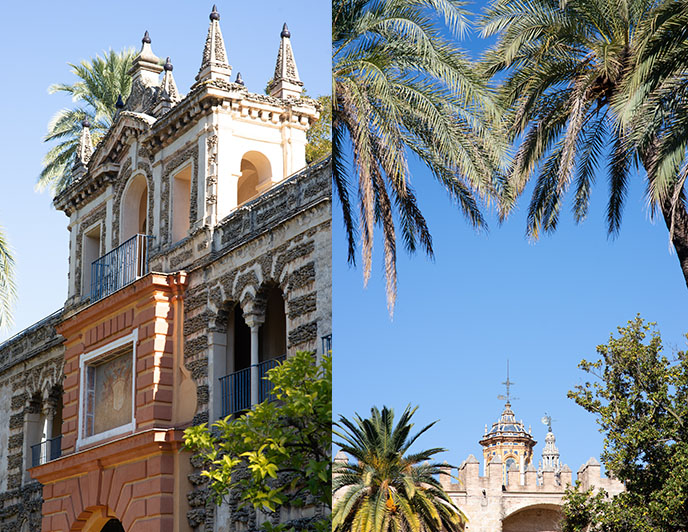
I visited Seville in November 2021, so the weather was comfortable. (I encourage you to avoid visiting the Iberian Peninsula in the summer, when temperatures are excruciating and it’s difficult to walk around outside and enjoy the gardens.)
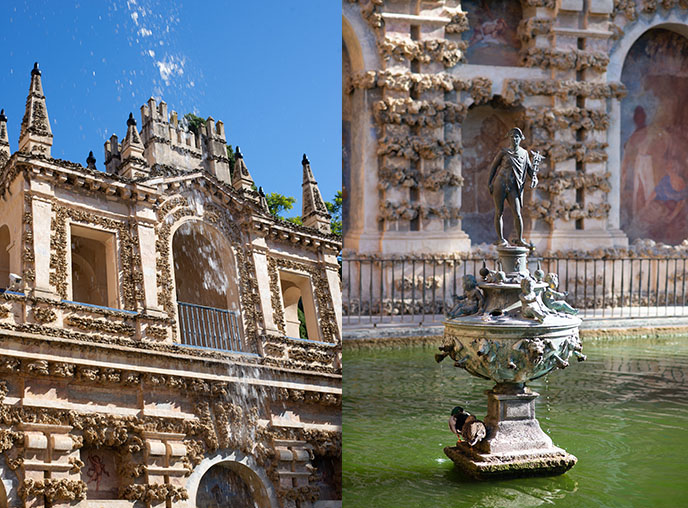
Here are the “Water Gardens of Dorne,” as featured in Game of Thrones. What better place for strolling with royals, and plotting to take down your rivals?

Don’t forget to look up — above is the ceiling of the Hall of Ambassadors.
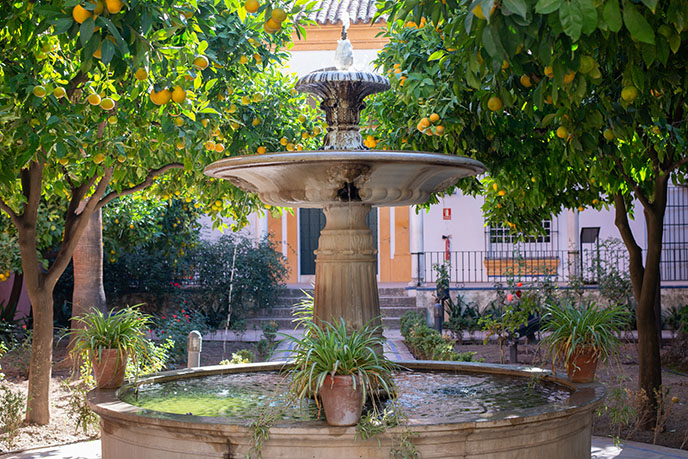
The famous oranges of Seville frame a fountain. (Photos by Joey Wong.)
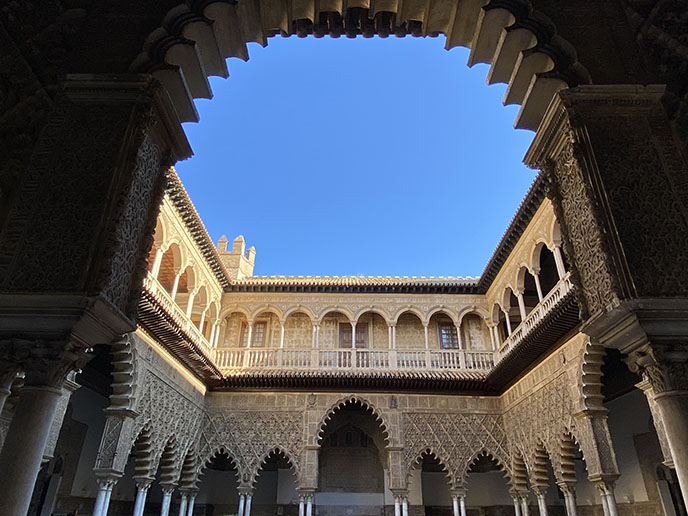
If you’d like to visit Real Alcazar, be sure to get tickets in advance via their official site. Plan ahead, as bookings may sell out.
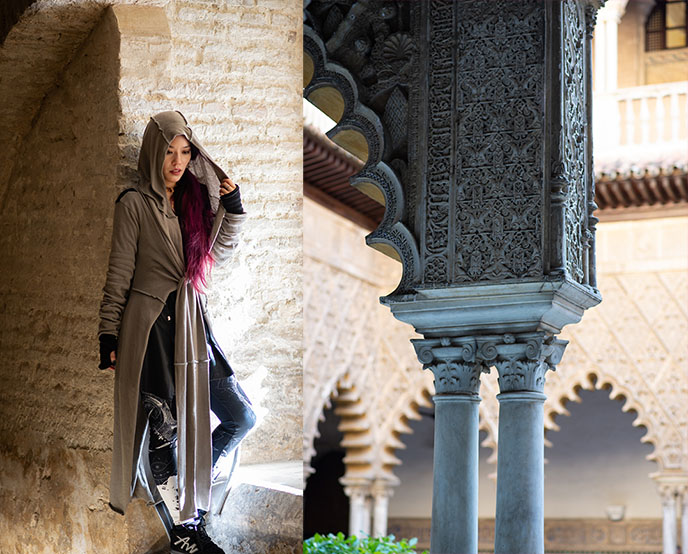
I’ve been on a post-apocalyptic, dystopian, cyberpunk kick — and Dorawyn lets me live out my fantasies. Her fashion is made from slow and sustainable methods, such as hand-dying and knitting with recycled cotton. Each piece is handmade and conveys a unique feeling; I haven’t seen styles like these anywhere else.
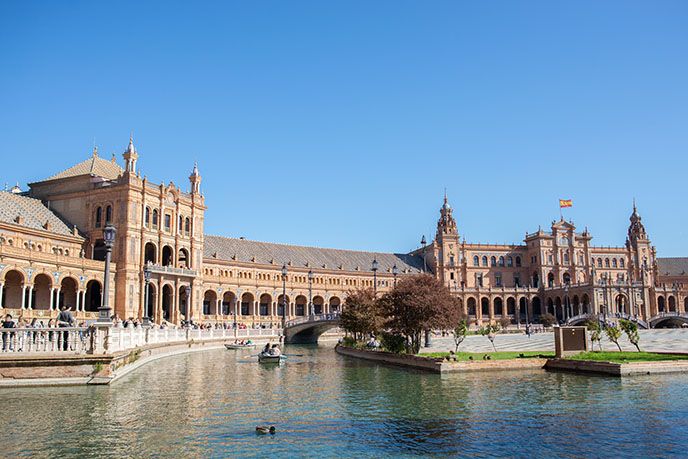
Onward to the Plaza de España, which turned out to be one of my favorite spots in Seville. You may recognize it as the shoot location for scenes in Lawrence of Arabia (1962) and Star Wars: Episode II – Attack of the Clones (2002) (it stands in for the City of Theed on the Planet Naboo).

A close-up on one of the many devilish details. The Spain Square was built in 1928 for the Ibero-American Exposition of 1929.
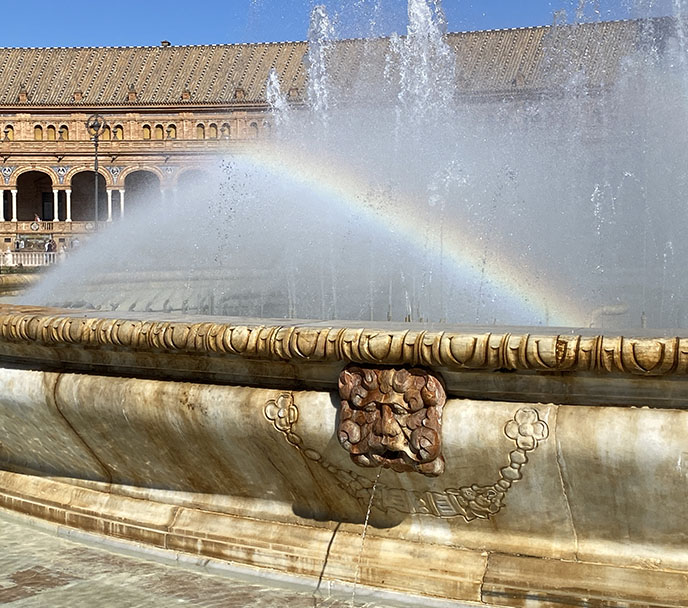
In the centre is the Vicente Traver fountain. The water shoots up high, framing the central building of Plaza de Espana and glowing with rainbows.
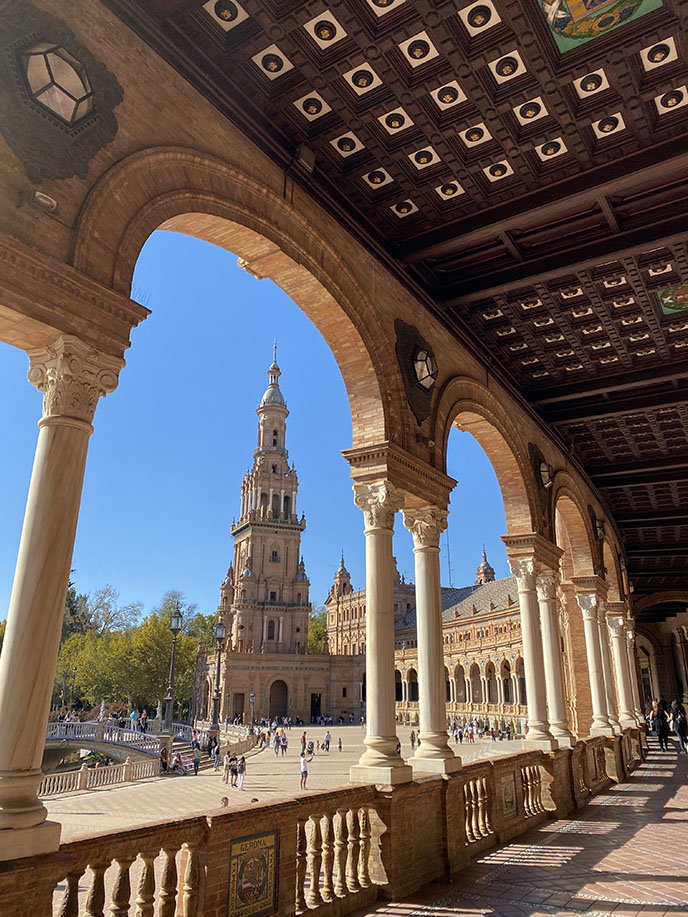
Plaza de Espana is designed in a huge half-circle. The buildings are accessible by four bridges over a moat, which represent the ancient kingdoms of Spain.

This is a spectacular site for photography (no wonder these corridors are in so many movies). Go during different times of the day, to make the most of the dramatic light and shadow.

Plaza de Espana is a free public space, and has a lively atmosphere with young locals hanging out on the steps.
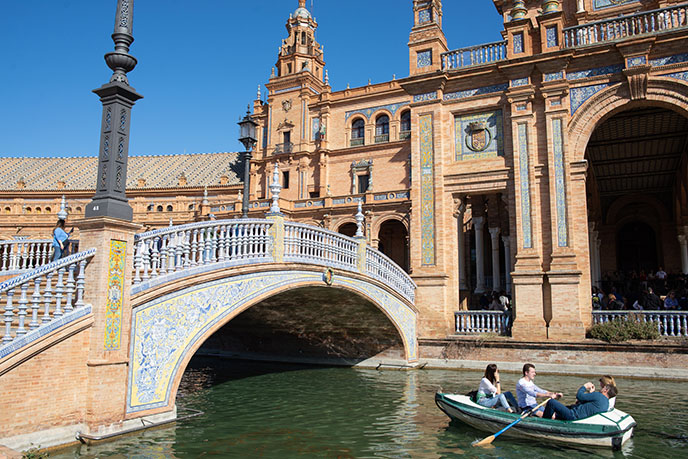
You can rent a cute blue and white rowboat, and paddle the canal that weaves through the pavilion.
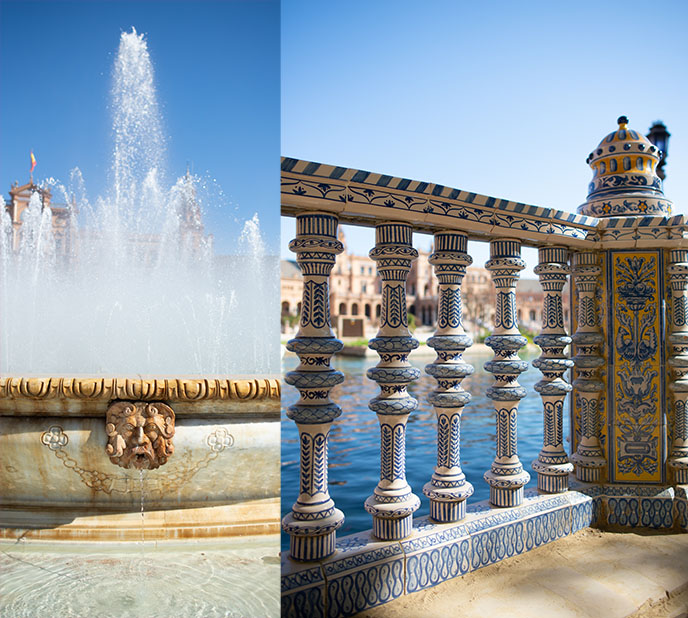
The Plaza de España was designed by Aníbal González, and sits next to Maria Luisa Park. The architecture is a playful, fantastical mix of 1920s Art Deco, Spanish Renaissance Revival, Spanish Baroque Revival and Neo-Mudéjar styles.
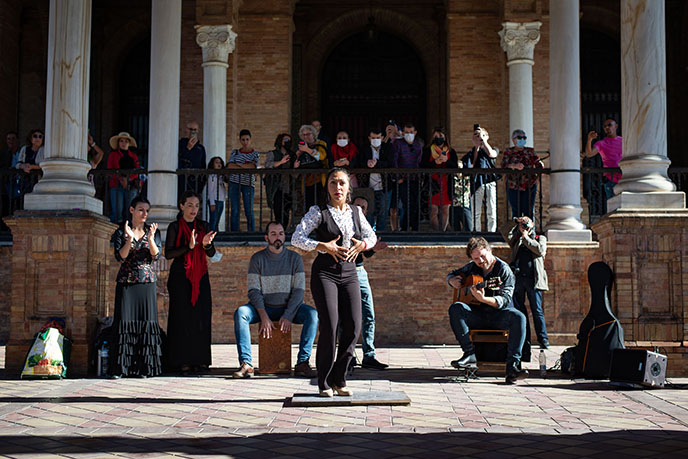
When I visited, there were two groups of flamenco dancers performing for free. The singing, stomping, and strums of guitar added to the vivacious atmosphere of Plaza de Espana.
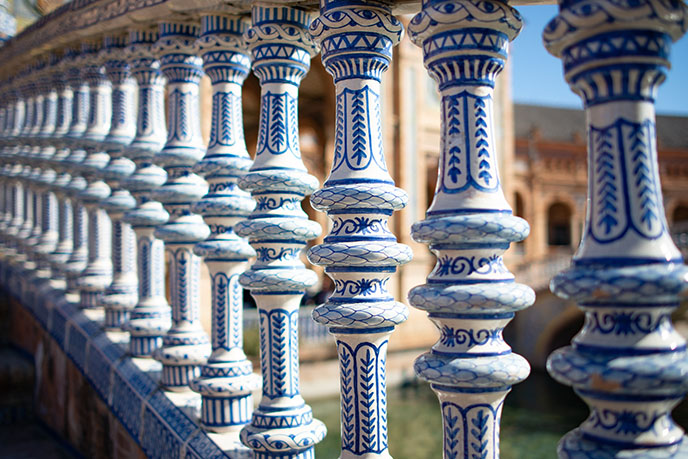
Closet up on the ceramic white and blue painted balustrade.
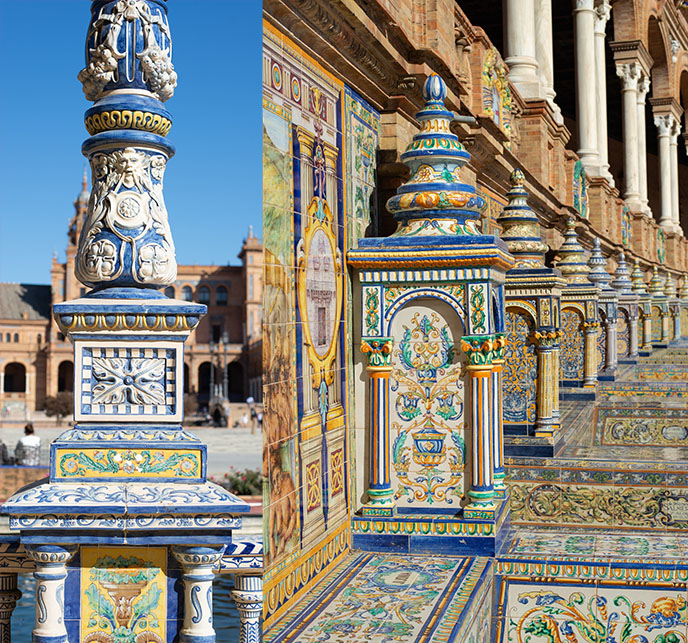
And the colorful tiled Provincial Alcoves along the walls of the Plaza de España.

Access to Plaza de España is free. Hanging out here was one of my favorite experiences in Seville, Spain.
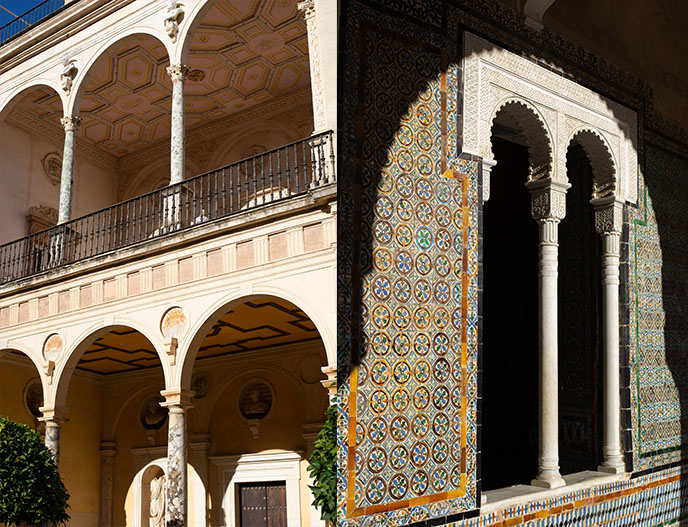
Finally, a look inside the stunning La Casa de Pilatos (Pilate’s House). This Andalusian palace was built in 1483, and was the permanent residence of the Dukes of Medinaceli.

Casa de Pilatos has one of the largest collections in the world of azulejo (Spanish glazed tiles), arranged in majestic colorful formations.

Parts of Lawrence of Arabia were filmed in the mansion. I arrived at golden hour, which was ideal for dramatic portraits.
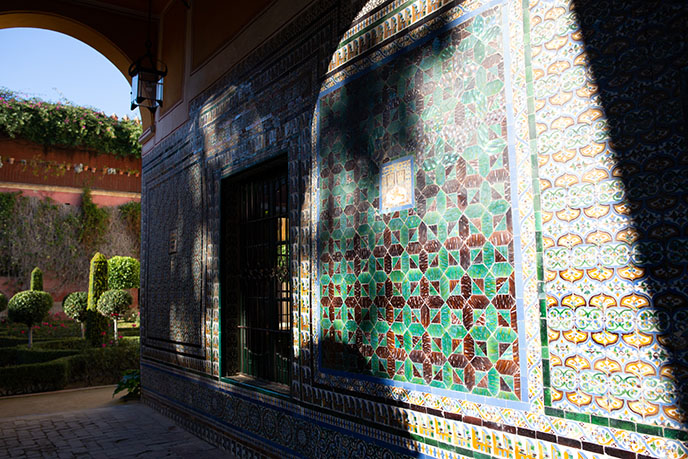
The Casa de Pilatos is small but worth visiting, as it is one of the finest examples of 15th century Andalusian architecture.
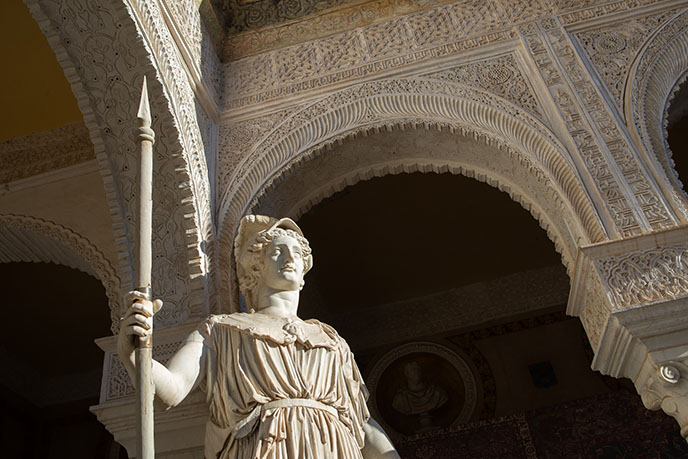
In addition to the architectural details, you can admire classic paintings, furniture and sculptures.

The rear contains two lovely tiled gardens, filled with flowers and manicured in a 16th century style. To visit Pilate’s House, order tickets in advance from Fundación Casa Ducal de Medinaceli’s site.
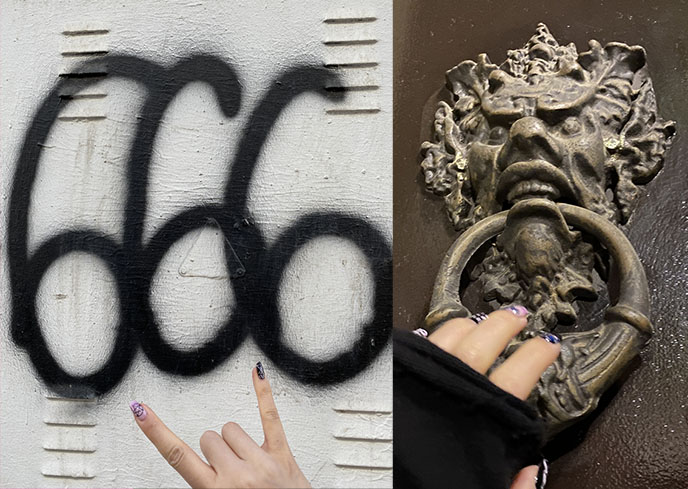
I leave you with a few devilish snaps from Seville. (I have some Satanic news coming up for you soon… stay tuned…)
For more Sevilla travel tips and photos, see my first post featuring Las Setas, the cathedral, and more.

 LA CARMINA
LA CARMINA






